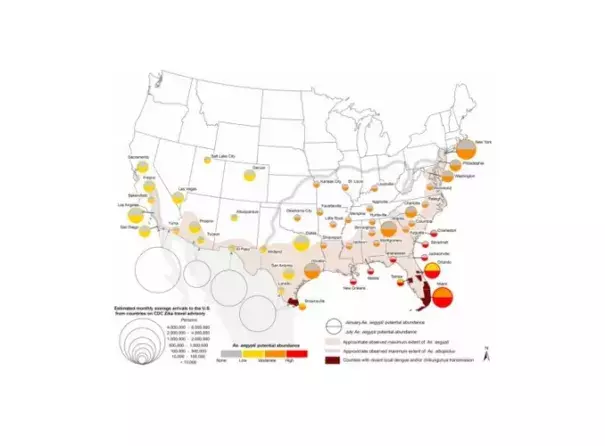Headline
These are the U.S. Cities That Could be Hit by a Zika Outbreak
United States

U.S. map showing 1) Ae. aegypti potential abundance for Jan/July (colored circles), 2) approximate maximum known range of Ae. aegypti (shaded regions) and Ae. albopictus (gray dashed lines), and 3) monthly average number arrivals to the U.S. by air and land from countries on the CDC Zika travel advisory. Image: Andrew J. Monaghan et. al. PLOS Currents: Outbreaks
A recent study in the journal PLOS Currents: Outbreaks found fifty U.S. cities where the six-legged, blood-sucking vector of the virus — the mosquito Aedes aegypti — would be able to survive in the upcoming summer months. Nine of those cities, home to an estimated 14 million people, could have a “high abundance” of the virus-carrying mosquitoes by July, the study says, and the mosquito could be a problem as far north as New York
Related Content
Science Source
| The Lancet
El Niño and climate change—contributing factors in the dispersal of Zika virus in the Americas? - The Lancet
Shlomit Paz, Jan C Semenza
Science Source
| Proceedings of the National Academy of Sciences
Global risk model for vector-borne transmission of Zika virus reveals the role of El Niño 2015
Cyril Caminade, Joanne Turner, Soeren Metelmann et al
Headline

Apr 7, 2017 | Carbon Brief
Zika outbreak ‘fuelled by’ El Niño and climate change
Science Source
| MMWR. Morbidity and Mortality Weekly Report
Vital Signs: Update on Zika Virus–Associated Birth Defects and Evaluation of All U.S. Infants with Congenital Zika Virus Exposure — U.S. Zika Pregnancy Registry, 2016
Megan R. Reynolds, MPH; Abbey M. Jones, MPH; Emily E. Petersen et al


